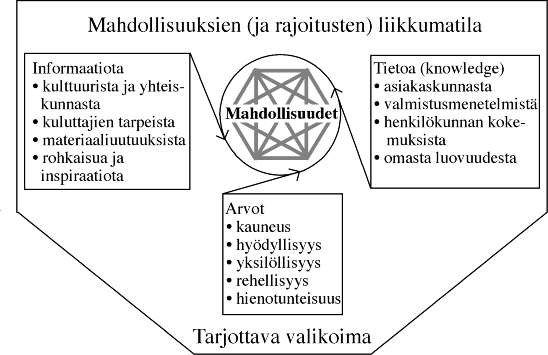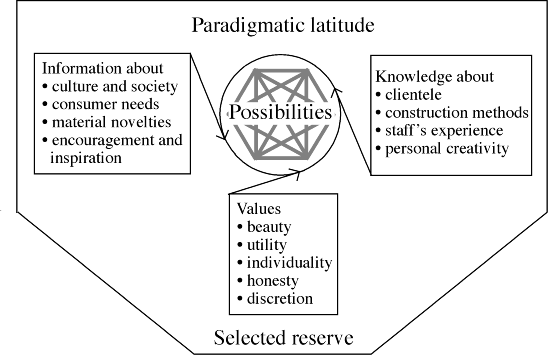
Tässä on pieni ote Ritva Koskennurmi-Sivosen käsityötieteen väitöskirjasta Creating a Unique Dress (1998), joka käsittelee muotitaiteilija Riitta Immosen työtä monesta näkökulmasta. Tämä palanen on suunnitteluprosessia koskevasta luvusta 8 (s. 195 ->), jonka alussa on käsitelty sitä mahdollisten ideoiden ja suunnittelun lähtökohtien liikkumatilaa (paradigmatic latitude), jonka puitteissa suunnittelija (couturière) tekee asiakkaalleen alustavan ehdotuksen puvuksi. Kuvion keskellä oleva häkkyräkuvio on alustava mielikuva tuotteesta. Se on mahdollisuus, joka toteutuu tai ei toteudu.
Kuviossa ja tekstissä on mukana myös tiedon osuus suunnitelmaan laatimiseen onnistumisessa. Vrt. mitä sanottiin tiedosta ja luovuudesta aiemmin tässä luennossa. Huom. englannin kielessä (jolla tutkimuskin on kirjoitettu) erotetaan saatu tai hankittu tieto eli information ja omaksi omaisuudeksi prosessoitu tieto eli knowledge. Kirjassa tässä kohdassa puhutaan myös arvoista, mutta tässä kohdin tekstiä on lyhennetty.
Sama kuvio, joka kirjassa on tekstipätkän lopussa on tässä suomennettuna heti alussa, mikä toivottavasti helpottaa lukemista.
Pienet linkkinumerot tekstin seassa ovat alaviitteitä, jossa on täydentävää tietoa.

In this chapter I will discuss the findings of the investigated designing and making-up process of unique dresses. The process itself is described and conceptualized from the couturière’s, dressmakers’ and other coworkers’ points of views using data primarily obtained from these persons complemented with additional data representing the clients and mannequins, as outlined in section 6.4.
Paradigmatic latitude (1) is the realm of possibilities in which the couturière moves. She creates her own paradigm, a selected reserve of possibilities, in order to be prepared to meet the requirements of the designing situations. Selecting is made possible by virtue of her knowledge, information, and underpinning values.
What concretely happens in the first phase of a process is the selection of materials. Taken in historical perspective, there had only been severe restrictions in the availability of fabrics in the early part of the investigated era. In normal times, supplies in the Western European market—even in the French market alone—are abundant. Paradigmatic latitude is about limited freedom; not just anything can enter it. Materials as well as ideas must meet certain criteria of quality and style. However, the selected reserve is not closed; it is continuously changing.
While paradigmatic latitude implies certain limits, it does not imply that the designer has a limited mind in general. As the previous chapter revealed, different ideas have been developed outside this type of a designing system, and at times, atypical projects have been carried out in processes of this type. (2)
When the couturière’s work is based on long patronage relationships, she carries a reflection of the clientele in her mind. She knows her clientele not only as consumer segmentations but as individually met people, although she does not think of each of them individually when preparing herself for future designs. Rather, she is sensitive to the human nature and has a hunch about demand.
I know what people need. That belongs to my profession. (RI)
Both sensitivity and hunch have been vital for economic targeting in a small enterprise, although this aspect has never exceeded the judgement of the couturière’s own taste and intuition.
The ability to think of designs in terms of operational images is essential for a couturière who bases most of her work on material uniqueness. Looking for fabrics which are available in short lengths (i.e., in retail, not in bolts), she is able to estimate the approximate amount of fabric needed for various sizes and types of dresses. Likewise, as she is familiar with the techniques and materials of embroidery, she is accordingly able to perform these acquisitions.
That is exactly the advantage–that one masters the profession. It was never difficult. One could see how much of this and that was needed. Thus one keeps one’s memory, too. Whatever important things may be forgotten, they were never these things. That belongs to the profession. (RI)
In addition to her own immediate knowledge, the couturière transforms the feedback from her coworkers into her design capital. Experiences are mediated tacitly through the trace and fluency of both the cutter’s and the dressmakers’ work, and through explicit questions and comments of the workroom forewoman or the cutter.
The most important form of the couturière’s knowledge is the awareness of her own creativity—the urge to restart designing time after time.
Amazingly enough, one knows how [to create]. When we were in Paris and we saw what others do, I thought about how we are also able [to create] though one always needs to learn more; but we are able all the same. Appreciation is different there, and they have fundamentally good taste—the clients, too. What is important [to see and know] is how the client carries it. (RI)
General information that the couturière absorbs for her disposal consists of extensive and diffuse issues, such as cultural discourses and social, economic and political trends. She has always found it important to know what is going on in her own culture and society as well as across cultures and societies—be it about entertainment or the latest political jokes. (3) Representing various fields of society in which women work, the Soroptimist Club has been a regular source of current information to her. (4) More specifically, in her heyday, information was obtained from professional sources such as Women’s Wear Daily and Gurli Rosenbröijer’s Messages. In addition, information was continuously obtained from various professional publications and other designers’ work.
As a question and answer columnist, Riitta Immonen received invaluable information beyond her regular clientele. Those questions were useful for more a general understanding of women’s wishes and expectations and, thus, she was prepared to meet them.
Other specific sources of information include the suppliers of materials. Technical novelties of fabrics are introduced together with new styles. Both sorts of information are highly important to a field in which—besides the new and fresh looks—the primary interest is quality. The suppliers and the couturière share the common interest of keeping the standards of the field high.
The most personal form of information is the encouragement which confirms the couturière’s own ideas and stimulates new ones. This is acquired by seeing a diversity of dresses, especially well-crafted dresses. It is important to know what other designers create, although it is even more important to know how those designers’ clients wear their creations.
Acquiring information is also important for understanding one’s own position and work within the field of fashion as a whole and in the continuum of the couture tradition. This issue implies a certain awareness of what should be known in order not to launch old ideas as new; in other words, a sensitivity to psychological and historical creativity.
XX thought she had made a great invention of circular skirts. They cut a hole in the middle. She was not from the field and she did not know [how common an idea it actually was]. (RI)
Guided by her knowledge, information and values, a couturière provides herself with a reservoir of possibilities (5) : a limited paradigm. Materially, this consists of lengths of fabrics and related supplies.
It would not make any sense to look for something particular. It may have been that one needed something and then asked for it. [Ideas] arose at the same time when one saw those lengths of fabric... Sometimes, exceptionally, I needed to seek something. That rarely happened. It was always found. (RI)
Immaterially, possibilities consist of the initial mental images of potential products. Most often they are related to materials even though some of them are not. Possibilities come and go, and some ideas never take on a material form.
Today I designed a sexy dress. Would you like me to tell what that dress is like? (Of course.) It is of two materials. It consists of a skirt and an apron. The back is completely bare, and in the front it is like an apron. The skirt is of different material, and the two materials are joined in the back waist with a conspicuous button. (Did you sketch it?) No, I just designed it. (Who is it for?) Nobody. It’s just one possibility, but maybe we will make it some day. (RI) (6)
Possibilities are fluid combinations of orienting and operational images. In the creation process, both of these are reflected on, but neither one is fixed. The orienting images do not constitute complete syntagms as they will be put together in the subsequent process. Rather, a possibility implies an abstract awareness of what sorts of creations are worth making up uniquely. Some ideas may be interesting, but they would be at their best in industrial production, for example. Then they do not belong to the paradigmatic latitude of unique creations.
Possibility is a kind of a play. It is a dream. It is like an art exhibition where one has the possibility to buy though perhaps one doesn’t buy. In reality one must always have sense. The real dresses are beautiful and usable. (RI)

(1) I refer to Barthes’s paradigm which he discarded in favor of system (section 2.5 in this volume). In the broader sense, both concepts suggest an ensemble of units, functions, and constraints. In the restricted sense, the terms are opposed to the level of syntagms–actualized combinations selected out of the former (Barthes 1967, 59; 1983, 162). Although I refer to Barthes, my use of paradigmatic is not aimed to imply his cynical conception of fashion as a recycling of signs. Latitude is inspired by Lipovetsky’s (1994) use of the concept in the context of fashion (section 2.6 in this volume). Latitude implies movability amidst relative freedom to reject, modulate or accept what is available.
Together paradigm and latitude imply somewhat of a tautology though alone neither one would justify the idea of the couturière’s movability in the early phase of the process.
(2) The list of the suppliers and the dress data support this idea of limited movability.
(3) Even now when she is approaching her eighties and only designs occasionally, Riitta Immonen keeps herself updated with politics, new and old restaurants, exhibitions, and museums both in Finland and abroad. She may stay up nearly all night if a new and interesting interesting music video or a documentary is released on international television at an inconvenient hour. Furthermore, she has still a permanent personal contact in Paris.
(4) Although Riitta Immonen resigned her membership in 1996, contacts with people in various professions remain important to her.
(5) I have selected possibility from Riitta Immonen’s personal speech. However, I would like to assign it a conceptual status which refers to the early ideas in the designing process.
(6)This quotation is from as late as December, 1997. However, I believe that it also represents the notion of fluid ideas not necessarily connected to the acquisition of materials at any one time of the studied career.